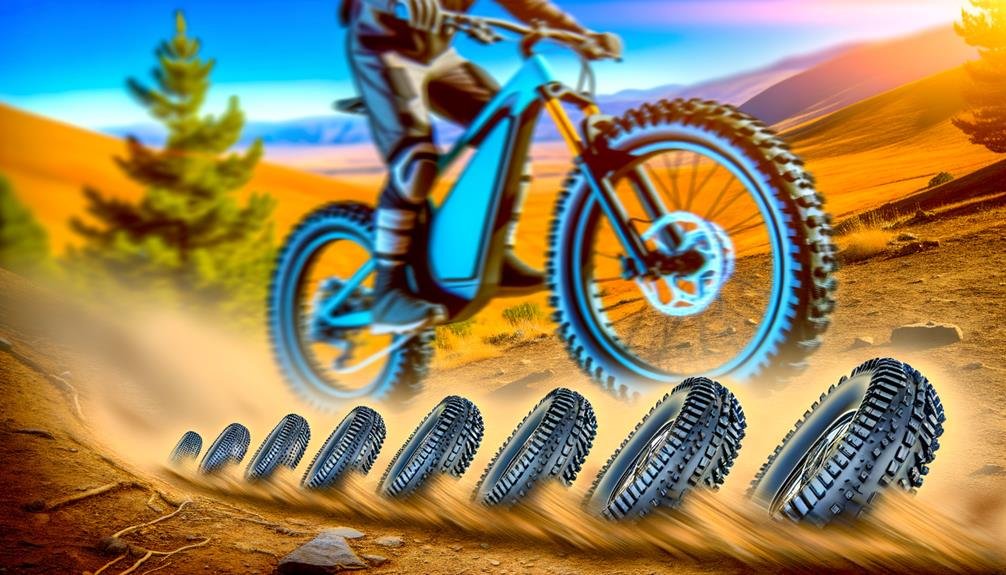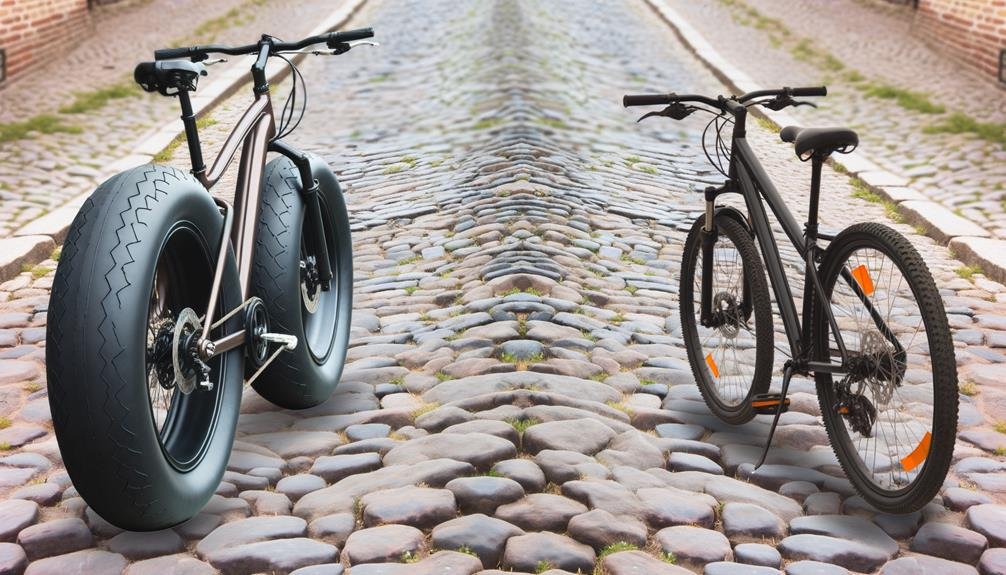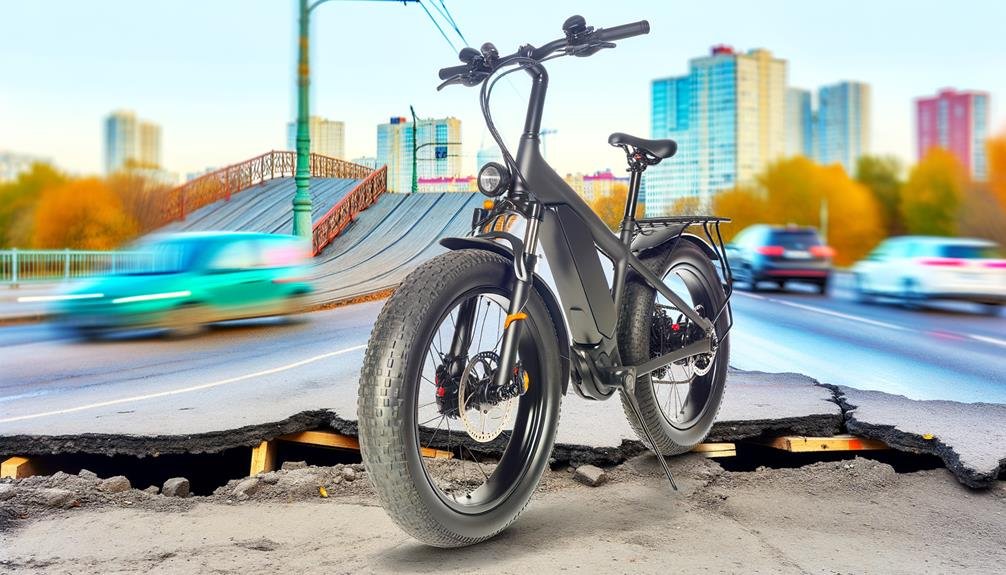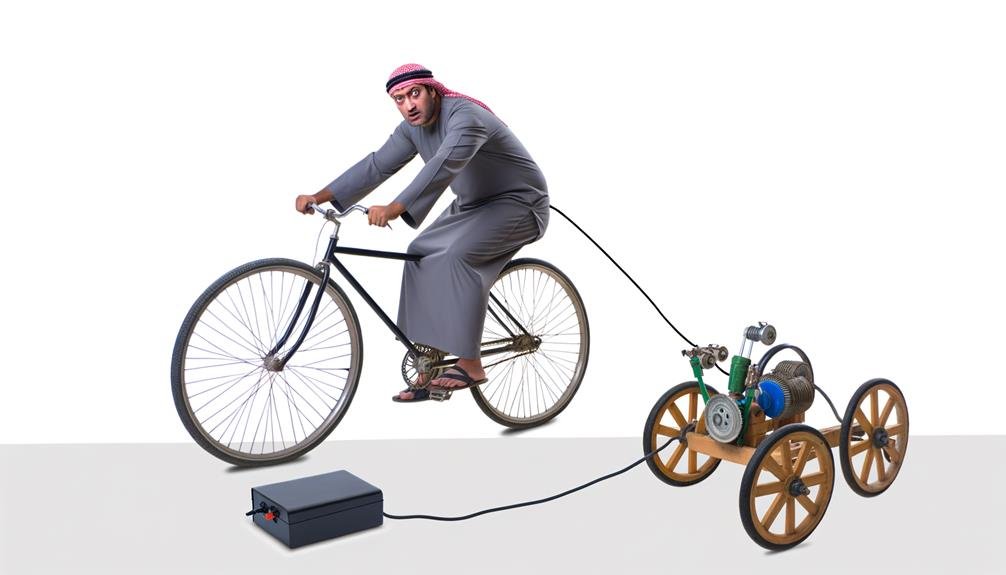Charles Miller is a veteran bike enthusiast with over 12 years of experience dealing with bikes as a mechanic. Despite immense love and expertise for...
We've all noticed the increasing popularity of electric bikes with remarkably fat tires cruising our city streets and trails. Perhaps you've wondered, just as we have, why these bikes have such substantial tires. Are they merely a design fad or is there a practical reason behind it?
Fat tires on electric bikes are not just for looks; they have specific functions and benefits that enhance the biking experience. We're going to unpack the reasons behind this trend, and by the end, you'll understand why this is more than a passing fad.
- Key Takeaways
- Understanding Electric Bike Tires
- The Impact of Tire Size
- Advantages of Fat Tires
- Potential Drawbacks of Fat Tires
- Comparing Thin and Fat Tires
- Fat Tires and Ride Comfort
- Performance of Fat Tires Off-Road
- Navigating City Streets With Fat Tires
- Choosing the Right Tire for You
- Frequently Asked Questions
- Conclusion
Key Takeaways
- Fat tires provide superior traction and grip on various terrains, making them ideal for off-road adventures and navigating challenging surfaces like sand, snow, or gravel.
- They enhance shock absorbency, resulting in a smoother and more comfortable ride, especially on bumpy or uneven terrains.
- Fat tires are less prone to punctures and flats, increasing the versatility and reliability of electric bikes.
- The wider contact area of fat tires improves stability and control, offering enhanced safety for riders, particularly on slippery or wet surfaces.
Understanding Electric Bike Tires
To fully appreciate the functionality and benefits of electric bikes with fat tires, we must delve into their unique design and how it influences their performance across different terrains.
Fat tire e-bikes, specifically, sport tires that are four inches wide or more, presenting a broad contact area with the ground. This larger surface area significantly improves grip and traction, making these e-bike tires a perfect match for challenging terrains like snow, sand, and mud.
Understanding electric bike tires further, we find that the low pressure and wider construction of fat tires provide enhanced shock absorbency. This design translates to a more comfortable ride, better absorbing bumps and vibrations. However, it's not all smooth riding. The larger, heavier design of tires on e-bikes can lead to increased electricity consumption and slower acceleration.
In essence, the choice between fat and skinny tires hinges on individual preferences and specific requirements. While fat tire e-bikes offer better traction and comfort, they may compromise on speed and energy efficiency. It's a delicate balance, and understanding electric bike tires is key to finding the right fit for your biking needs.
The Impact of Tire Size
Delving into the impact of tire size, we find that the wide, fat tires on e-bikes, measuring four inches or more, significantly boost grip and traction due to their extensive ground contact area. This increased contact area not only improves stability on different terrains but also enhances balance while riding, contributing to the overall safety of electric bikes.
The weight of the e-bike also plays a significant role. The larger diameter of fat tires adds to the weight, providing a lower center of gravity, which further boosts stability. Additionally, the thicker construction of these tires offers improved shock absorbency and ride comfort, making the ride smoother even on rough terrains.
However, the impact of tire size isn't always positive. Fat tires can lead to increased electricity consumption and slower acceleration, possibly reducing the e-bike's efficiency. Maneuverability might also be compromised, affecting the bike's portability and customization options.
Interestingly, many e-bike manufacturers, like EVELO, prefer plus-sized tires. These offer a balance between weight and performance, presenting a viable alternative to fat tires.
As we delve deeper into the world of electric bikes, understanding the impact of tire size becomes critical.
Advantages of Fat Tires

While the impact of tire size on electric bikes may have certain drawbacks, it's important to note that fat tires bring a host of advantages to the table, particularly in terms of stability and control across various terrains.
Fat tires, with their larger surface area, provide excellent traction, which is crucial when navigating through loose surfaces such as sand, snow, or gravel.
The advantages of fat tires don't end with stability and control. They also provide better grip, reducing the risk of skidding in wet or slippery conditions. This feature allows riders to maintain a steady course, ensuring a safer ride.
Moreover, fat tires enhance shock absorption, making way for a smoother ride, even on bumpy or uneven terrains. The extra volume of these tires acts as a natural suspension system, absorbing the shocks from the ground, thus reducing the impact on the rider.
Furthermore, fat tires are less prone to punctures and flats due to their robust construction. This makes them perfect for off-road adventures, adding to the versatility of electric bikes.
Potential Drawbacks of Fat Tires
While we appreciate the benefits of fat tires on electric bikes, it's important to also consider potential drawbacks.
The increased friction and weight of these tires can lead to higher energy consumption, reducing the bike's battery life.
Additionally, the added weight can slow acceleration and make steering more difficult, while also increasing maintenance costs and reducing portability.
Increased Energy Consumption
Despite the myriad benefits of fat tires on electric bikes, they significantly amplify energy consumption due to their increased friction and weight.
The overall weight of these tires results in slower acceleration and harder steering, demanding more from the electric bike's motor.
The rolling resistance of a fat tire is higher, causing the bike to consume more power and drain the battery faster.
While increased motor wattage can counteract speed reduction, it further inflates energy consumption.
Larger frames, rims, and axles make fat-tire electric bikes less portable and more challenging to handle, necessitating even more power to operate effectively.
Though they allow us to navigate difficult terrains, fat tires do pose considerable energy consumption challenges.
Maneuverability Challenges
Navigating the world of fat tires on electric bikes can present a few key maneuverability challenges. One of the primary challenges is the limited agility that fat tires offer. With their bulkier profile, it becomes harder to navigate tight spaces, which can be a significant challenge for riders who frequently ride in crowded or compact areas.
Another challenge with fat tires is the increased resistance when steering. The wider profile of fat tires leads to more resistance, which can make executing quick maneuvers more difficult. This resistance can affect the overall handling and responsiveness of the bike, requiring riders to put in more effort when steering.
Sharp turns can also pose a challenge when riding fat-tire electric bikes. The wider tires make it harder to maintain balance and control when making sharp turns, which can be a source of frustration for riders who need to navigate tight corners or winding paths.
In addition to maneuverability challenges, the hefty design of fat-tire electric bikes can also be a drawback when it comes to transportation and lifting. The weight of the bike can make it more challenging to transport, especially if you need to load it onto a vehicle or carry it up and down stairs.
Despite these challenges, many riders still find that the benefits of fat-tire electric bikes outweigh their drawbacks. The increased stability and traction that fat tires provide can make them ideal for off-road adventures or riding on uneven terrain. The wider tires also offer enhanced comfort and shock absorption, which can be beneficial for longer rides. Ultimately, the decision to choose a fat-tire electric bike should depend on your specific needs and preferences as a rider.
Higher Maintenance Costs
Grasping the potential drawbacks, it's important to consider the higher maintenance costs often associated with fat tires on electric bikes. Fat tires often experience more wear and tear due to their increased contact with the ground. This leads to frequent cleaning, tire replacements, and repairs. Furthermore, the additional weight and size of these tires put more strain on the bike's components, necessitating more maintenance.
| Potential Issue | Implication |
|---|---|
| Increased wear and tear | More frequent replacements |
| Debris buildup | Regular cleaning needed |
| Specialized construction | Expensive repairs |
| Higher energy consumption | Increased battery usage |
| Strain on bike components | Frequent repairs |
For those who view their electric bikes as not just a mode of transport, but a part of their identity, these maintenance costs and the demands of a fat tire bike might be a significant consideration.
Comparing Thin and Fat Tires
Now, we're going to analyze the performance difference between thin and fat tires.
We'll examine how thin tires, optimized for speed and lower pressure, contrast with fat tires known for their superior grip and traction.
We'll also look at how these differences impact their efficiency, speed, stability, and balance on various terrains.
Thin Vs Fat Tires
When comparing thin and fat tires, it's crucial to understand that each type offers distinct benefits and drawbacks depending on the specific use and terrain.
Thin or skinny tires, common on traditional electric bikes, are typically faster and more efficient on smooth paved surfaces due to less rolling resistance.
Fat tire bikes, on the other hand, have a wider tire width which grants them better grip and traction on difficult terrains such as snow, sand, and mud.
However, these fat tires can lead to increased electricity consumption and slower acceleration due to their larger design.
Ultimately, the thin vs fat tires debate boils down to individual preferences and the specific requirements of your biking adventures.
Choose wisely to truly belong to the e-biking community!
Performance Impact Analysis
To analyze the performance impact of thin versus fat tires on electric bikes, let's first consider the enhanced grip and traction fat tires provide due to their larger contact area with the ground. This improvement is especially noticeable on tricky type of terrain such as sand, snow, or mud.
The benefits of fat tire bikes don't stop there; these wider tires also offer improved shock absorbency and ride comfort due to their low pressure and wider construction.
However, it's key to note that fat tire bikes can have a slower acceleration and increased electricity consumption. Optimizing the motor wattage can help to counteract this.
Ultimately, the performance impact analysis between fat and thin tires depends on your specific requirements and preferences.
Fat Tires and Ride Comfort

With fat tires on electric bikes, riders enjoy superior shock absorbency, resulting in a significantly smoother and more comfortable experience. Imagine gliding over rough terrains with ease; that's the advantage of having a fat tire on your e-bike.
There are four key reasons why your ride comfort on electric bikes significantly improves with fat tires:
- Shock Absorbency: The wider tire design effectively absorbs shock from bumps and vibrations on the road. This makes your ride smoother, reducing strain on your body.
- Increased Traction: The wider contact area of fat tires enhances grip and control, providing stability on various terrains. You'll feel more confident and secure while riding.
- Versatility: Fat tires can handle a range of terrains such as snow, sand, mud, and rocky paths. This adaptability ensures riders have a comfortable ride in various conditions.
- Lower Pressure: Fat tires operate at lower pressures, which further aids in shock absorption. This enhances the overall ride comfort, making your journey more enjoyable.
Hence, if ride comfort is your priority, an e-bike with a fat tire would be your best choice.
Performance of Fat Tires Off-Road
Delving into the performance of fat tires off-road, it's clear that their excellent grip and traction significantly enhance stability and control on varied terrains. These chunky tires, characteristic of fat-tire bikes, are engineered to handle different terrains with aplomb.
Our analysis reveals that the wide footprint of these tires distributes the weight of the electric bikes over a larger surface area. This not only improves traction but also reduces the risk of punctures and flats – a common concern when adventuring off-road. This makes fat tires ideal for a mountain bike or any off-road escapade.
Furthermore, these tires have improved shock absorbency, smoothing out the bumps on rough terrains. This means riders can traverse through sand, mud, or snow with relative ease. They perform exceptionally well in sandy terrains and during specific off-road adventures where maximum shock absorption is needed.
Navigating City Streets With Fat Tires

Ever wondered how fat tires fare on city streets? The popularity of fat tires on electric bikes isn't just for off-road adventures. It's also about navigating city streets with fat tires. Here's why:
- Grip and Traction: Fat tires provide excellent grip and traction on various terrains, including city streets. This enhances stability and control, allowing us to navigate urban jungles with ease.
- Shock Absorbency: The wider the tire, the better the shock absorbency. This means a smoother ride on bumpy city roads, making your commute more comfortable.
- Safety and Stability: Fat tire bikes offer enhanced safety and stability. They're especially beneficial for novice riders, making it easier to handle unexpected obstacles or road conditions.
- Durability: Fat tires are resistant to punctures, reducing the risk of flat tires. This ensures a reliable commute through city streets, even in the face of potholes and debris.
And let's not forget the unique aesthetic appeal of fat tires – they certainly make your e-bike stand out in the urban crowd.
Choosing the Right Tire for You
Having discussed the benefits of fat tires for city riding, it's crucial we now turn our attention to how you can choose the right tire for your specific needs and preferences. Key to finding the best is understanding the important factors that contribute to making the right decision.
First, consider the size and weight of the tire. Wide or fat tires are typically 4 inches or more. They offer better stability and traction, particularly on uneven terrains. Yet, it's worth noting that the width directly impacts the bike's rolling resistance, acceleration, and maneuverability.
Next, evaluate the terrain you'll be riding on. A rocky or sandy trail demands a wider tire for stability, while smooth, paved surfaces are better suited for narrower tires.
Your specific riding preferences play a significant role in choosing the right tire for you.
Frequently Asked Questions
Are Fat Tires Better on an Ebike?
We believe fat tires enhance an ebike's stability, off-road capabilities, and tire durability. However, they impact speed and energy efficiency negatively. It's about balancing these factors for your specific needs.
What's the Point of Fat Tire Bikes?
We love fat tire bikes for their terrain versatility and enhanced stability. They're a comfort factor on bumpy rides, adapt to weather changes like a chameleon, and their visual appeal is just the cherry on top.
Are Fat Tire Bikes Harder to Pedal?
We've noticed that fat tire bikes do require more pedaling effort due to increased tire resistance. This can impact fitness positively, yet affect speed negatively. The terrain's influence may also alter the pedaling difficulty.
What Are the Disadvantages of a Fat Tire Bike?
We've noticed fat tire bikes bring along tire maintenance challenges, terrain limitations, and portability issues. They're heavier, causing speed reduction, and their increased weight can be a real pain. They're not without their disadvantages.
Conclusion
In a nutshell, we believe that the fat tires on electric bikes are a boon, not a bane. They provide superior grip, enhanced stability, and a smoother ride, making them a real game-changer.
Sure, they may be a bit heavier and slower, but the benefits they offer are worth the trade-off. They're like the Swiss Army knife of bike tires – versatile, reliable, and ready for any terrain.
Choose wisely and let your e-bike adventures begin.

Charles Miller is a veteran bike enthusiast with over 12 years of experience dealing with bikes as a mechanic. Despite immense love and expertise for his Tacoma, he rides his Trek Ebike more. Anytime you meet him, you’ll either hear him talking about Bikes, or writing about all things bikes and cars on this blog.
More Posts


